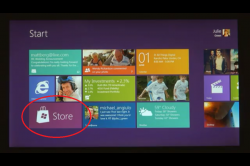On Wednesday, Microsoft offered the first glimpse of Windows 8, a sneak peek reveals much about both the influences and strategic goals of the major overhaul of Microsofts 25-year-old operating system.
The fundamental goal with the new operating system, which is being shown for the first time at D9, is to create something that is equally well at home on an 8-inch tablet as it is on a powerful desktop attached to a huge monitor.
Its no compromise and thats really important to us, Windows President Steven Sinofsky said in an interview with AllThingsD.
At the heart of the new interface is a new start screen that draws heavily on the tile-based interface that Microsoft has used with Windows Phone 7. All of a users programs can be viewed as tiles and clicked on with a touch of a finger.
Windows 8 essentially supports two kinds of applications. One is the classic Windows application, which runs in a desktop very similar to the Windows 7 desktop.
The other type of application, which has to be written in HTML5 and Javascript, looks more like a mobile application, filling the full screen. Internet Explorer 10, which is part of Windows 8, has already been configured to run in this mode, as have several widget-like apps for checking stock prices and weather.
Although Microsoft didnt offer any details, the start screen that it is showing on Wednesday includes a prominent link to a store, ostensibly confirming that Microsoft plans to get in the business of directly distributing Windows programs, much as Apple has on both the iPhone and Mac.
Sinofsky noted that there were a few things that the iPad showed were missing from Windowsmost notably a touch-first interface and an app distribution mechanism and new business model for developers. Windows 8, as the product is currently code-named, is designed to address all three of those issues, while preserving compatibility with decades of existing Windows programs.
Although Windows 8 is clearly influenced by the iPad and other mobile devices, the plan for the new operating system has been in the works since Windows 7 shipped in July 2009several months before the iPad was first shown.
We really did take a step back after Windows 7, Sinofsky said. We were clearly influenced ourselves by phones.
Microsoft has also done work with the classic Windows desktop to make it more touch friendly, including using a new kind of fuzzy hit targeting to adjust for the fact that fingers are far less precise than a mouse. The goal, says chief designer Julie Larson-Green, is that classic apps, though designed for a keyboard and mouse, work well with touch. Apps taking advantage of the new programming layer, she said, are designed for touch first, but also work well with a keyboard and mouse.
Windows is growing more flexible in other ways. Microsoft said back in January that the next version of Windows would support ARM-based chips from Nvidia, Texas Instruments and Qualcomm, in addition to the traditional Windows processors from Intel and AMD. Though Sinofsky and Green used Intel-based machines for Wednesdays demo at D, Microsoft plans to demonstrate some of the ARM-based designs later today at the Computex trade show in Taiwan.
On a technical note, Sinofsky stressed that after decades of ever-increasing system requirements that characterized Windows releases through Vista, Microsoft is once again building an operating system that demands fewer resources than its predecessora trend started with Windows 7, which worked on all Vista-compatible systems.
A key question is how well this new Windows will stack up against a new generation of post-PC devices running Android, Apples iOS and other operating systems.
There are other unanswered questions as well, including just when Windows 8 will be ready. Sinofsky declined to say, but said Microsoft will have a lot more to say about Windows 8 at a developer conference in mid-September in Anaheim, Calif.
http://allthingsd.com/20110601/exclusive-making-sense-of-what-we-just-learned-about-windows-8/
http://www.engadget.com/2011/06/01/microsoft-unveils-windows-8-tablet-prototypes/
----------
Looks awesome. I love the UI for a tablet, but not sure how well it will translate to a desktop.


